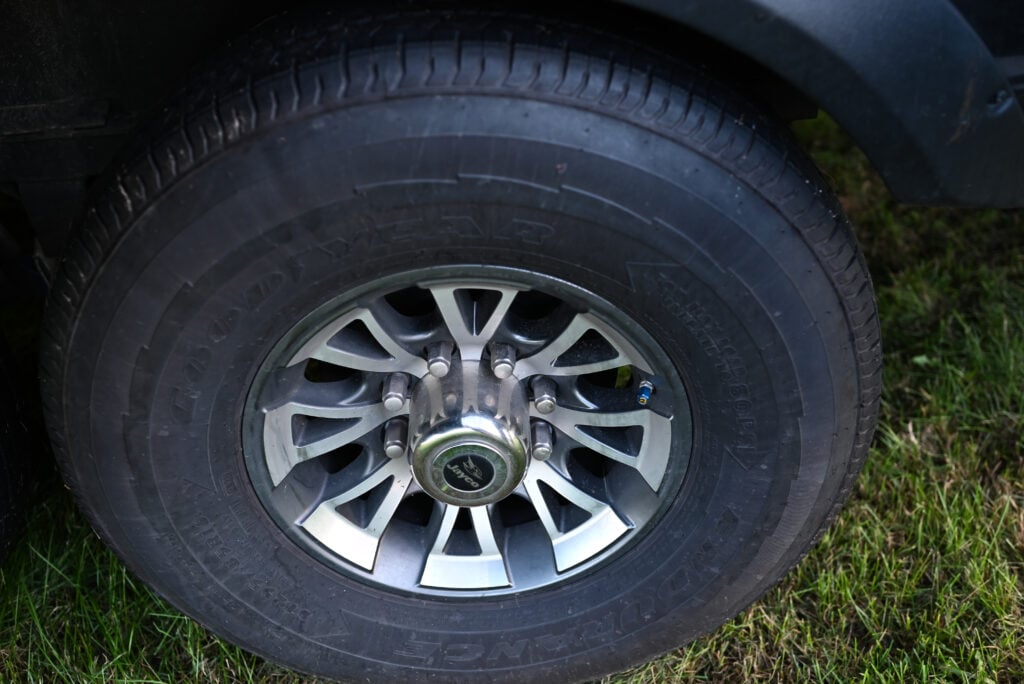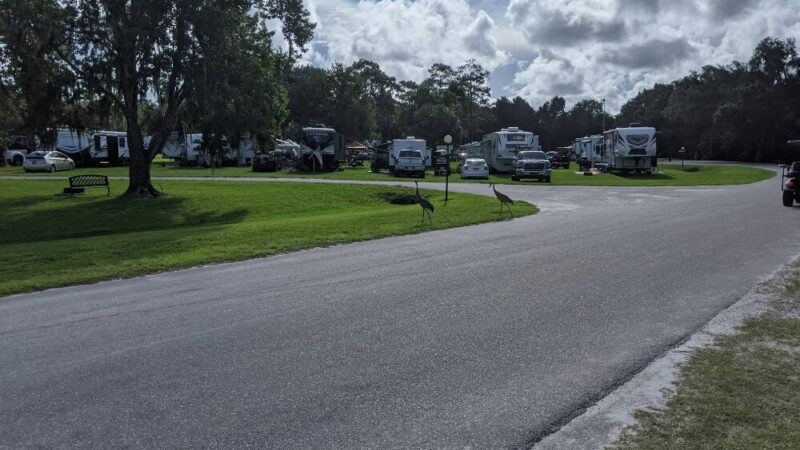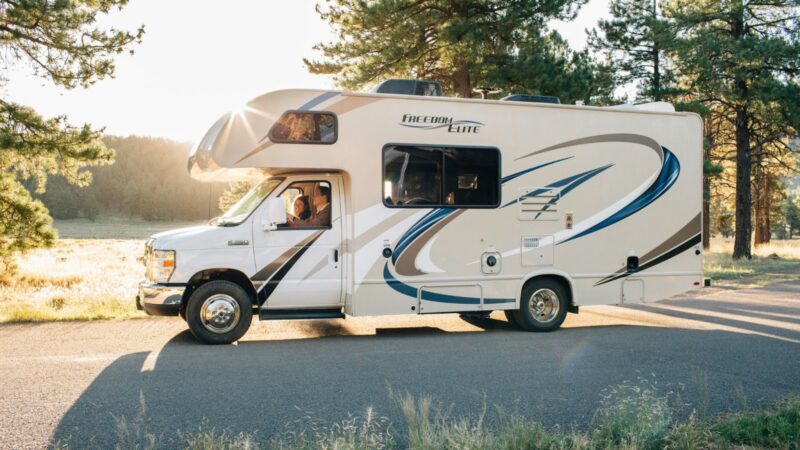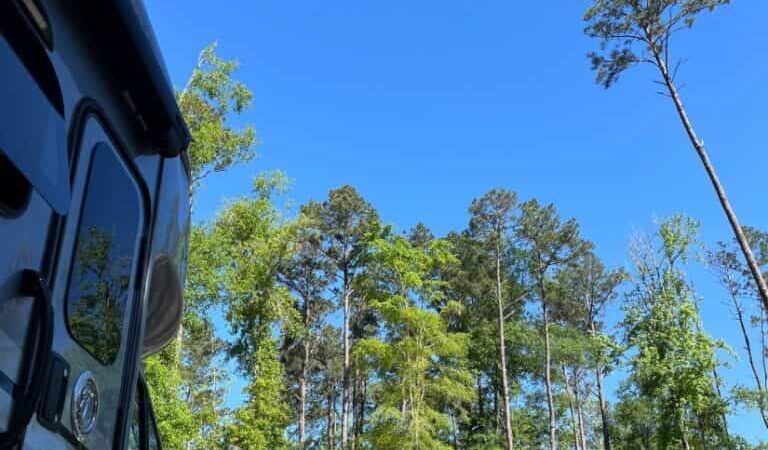How Often Should You Check RV Tire Pressure?

How Frequently Should You Check RV Tire Pressure?
Tires are literally foundational pieces for any RV. You won’t be able to go anywhere without properly inflated tires. Flat tires and blowouts are obviously a problem, but even the internal air pressure can have a big impact on your travel plans. So, if it’s so important, how frequently should you check your RV tire pressure?
Tires can develop issues at any time, but it’s usually a good idea to check them at least once a month during infrequent travel and every day that you plan to drive substantial distances. Checking your tire pressure before every trip may seem excessive, but this practice can save you time and money in the long run.
If you want to keep your RV roadworthy, you need to ensure your tires are in good shape. Below, we’ll discuss some factors that may influence tire pressure, as well as the importance of proper maintenance.
How/when to check tire pressure
Even though it’s frustrating to add another item to your to-do list, checking your tire pressure doesn’t have to take more than a few minutes. All you need is a pressure gauge and the recommended PSI range. Most tires have the recommended PSI printed on the exterior sidewall. If you can’t find this information, check your RV owner’s manual and see if they have any details about your tires.
Car tires are usually safe at around 36 PSI, but RV tires have a lot more range. They typically need higher pressure in order to sustain the weight of the vehicle, but the specifics can span between 45-110 PSI. So, there’s no one-size-fits-all answer to this problem.
Consult the tire information and manual to find the correct range for your RV. Then, you just need to remove the tire valve cap, insert the pressure gauge, and check the results. If it’s too low, head to an air pump to add a bit more pressure. If it’s too high, let a bit of air out of the tires. Simple enough!
In most cases, you can get by with only checking your tires every month or so. If you don’t drive your RV very often, this should be sufficient. But if you’re always on the move or are in the middle of a big trip, it’s a good idea to check your tire pressure every day. The more you use your tires, the more likely they are to develop problems.
Do I need a tire pressure monitoring system?
You may wonder if these manual checks are necessary at all. After all, a tire pressure monitoring system (TPMS) lets you check the pressure automatically, plus you’ll get an alert if there’s a sudden drop. Although a tire pressure monitoring system is highly recommended, you should still check your pressure in person once in a while.
Remember that these devices can fail, and although they’re good at detecting low pressure and leaks, they won’t always tell you if your tires are overfilled. You’ll need to check for that and adjust it yourself.
Tire pressure factors
It might seem strange that your tire pressure can change day by day. After all, it’s a sealed container, so air shouldn’t be coming in or out, right? As much as we’d like our tires to stay at the perfect level, there are a variety of factors that can affect your PSI measurement.
Age of tire
First up, consider the age of the tire. The older it is, the more likely it is to develop cracks and leaks. These flaws could be so small that you can’t see them, but they’re still causing air to leak out of your tire. RV tires should generally be replaced every 5-7 years, but you might have to swap them out even sooner if you don’t keep up with your regular maintenance tasks.
Temperature
Next up, temperature can also play a role! Tires are made of rubber, which is famously quite resilient to temperature changes. However, it’s still not perfect. With enough friction, they can still overheat, crack, and fall apart. Extreme shifts in temperature can also cause your interior pressure to fluctuate. Hot air expands while cold air contracts. This is why you might get different PSI ratings throughout the day, even if there isn’t a leak anywhere.
Altitude
Altitude is another factor to consider. You might travel through a variety of elevation changes during your trips, and your tires will react accordingly. The higher you go, the more pressurized your tires will be. The opposite is true of low elevations! You might lose some pressure if you travel to areas that are at sea level or lower. Therefore, you might want to adjust accordingly so you’re not driving on tires that are overfilled or empty.
Vehicle weight
The tires are responsible for supporting the weight of your RV. The heavier your rig is, the more compressed and pressurized they are. Overfilled tires are likely to pop if you’re packing too much weight.
An overweight RV is also dangerous to the other parts of the vehicle because it can warp the frame and throw off your center of gravity. Make sure your RV is within the recommended weight range so you can have a safe and uneventful drive!
Tire number/axle distribution
The type of RV you drive can also factor in here. The more tires you have, the more pieces you’ll have to balance. But if one tire goes down, a second one might be able to carry the load for a minute while you pull over to fix things.
The axle placement and tire distribution are also important. Tires that are located on the same axle need to match each other’s pressure so they don’t throw off the balance of your rig.
The importance of proper tire pressure
Managing all these different factors and tires can be annoying, especially if you have to check them every day. So what’s the big deal? Does your tire pressure really make that much of a difference? Yes!
Proper RV tire pressure is essential. When you’re driving a large and heavy rig, a blowout can lead to disaster. These situations are scary, plus they can be quite expensive to fix.
Maintaining a good level of tire pressure can also improve your overall experience in an RV. If your tires are filled to the correct level, you’ll have better control of your vehicle. You’ll also be able to improve your fuel efficiency because the wheels are spinning at the ideal rate, and you’re not fighting against the machinery.
This way, you can spend less time at gas stations and save money at the same time. Well-maintained tires will also last longer, so you won’t need to shell out hundreds of dollars for replacements every year.
All you need to do to gain these benefits is to monitor and adjust your tire pressure on a regular basis. You can rely on your tire pressure monitoring system most of the time, but don’t forget to manually check the pressure on occasion. If you perform a visual inspection, you will also be able to look for any developing issues.
Track your RV maintenance
Make sure you keep track of all your RV maintenance and repairs with an online tool such as RV LIFE Maintenance. Not only can you keep all of your documents in one place, but you’ll also receive timely reminders when maintenance is due to help you avoid costly repairs and potentially serious accidents.
Related articles:
- 8 Things To Consider When Replacing Tires For An RV
- The Benefits Of An RV Tire Pressure Monitoring System
- 5 Tips For Preventing Tire Blowouts In Your RV
The post How Often Should You Check RV Tire Pressure? appeared first on RV LIFE.







